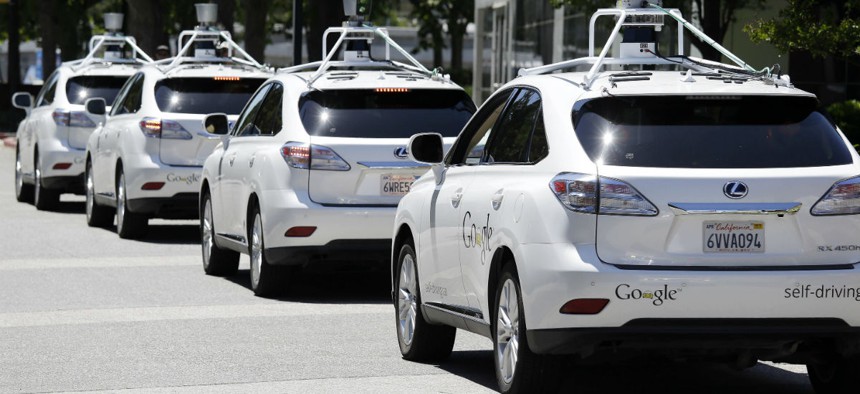Driverless Cars: Here’s What the Obama Administration Should Do Next

FILE - This May 13, 2014 file photo shows a row of Google self-driving Lexus cars at a Google event outside the Computer History Museum in Mountain View, Calif. AP Photo/Eric Risberg, File
On Dec. 4, President Barack Obama signed the Fixing America's Surface Transportation Act, which plans for a future of driverless cars
Gary Shapiro is president and CEO of the Consumer Technology Association, the U.S. trade association representing more than 2,000 consumer electronics companies, and author of the New York Times best-selling books, "Ninja Innovation: The Ten Killer Strategies of the World's Most Successful Businesses" and "The Comeback: How Innovation Will Restore the American Dream." His views are his own. Connect with him on Twitter: @GaryShapiro
On Dec. 4, President Barack Obama signed the Fixing America's Surface Transportation Act, a forward-looking transportation bill that not only funds infrastructure investment but also plans for a future of driverless cars. With strong bipartisan support, this landmark transportation-funding bill is good for our country’s transportation network and the vehicles that drive on it.
In the next five to 10 years, autonomous vehicles should make major inroads in the U.S. Driverless cars will reduce more than 90 percent of the annual 32,000 American vehicular deaths and 2.3 million car-related injuries. And the quicker we get there, the more lives will be saved and injuries avoided.
Already, cars are available that park themselves, keep you in your lane and avoid collisions. Every major car company is testing driverless cars, and recently Tesla sent its customers a download that automates many features in its fleet.
But we still have miles to go. Complex problems must be addressed and ethical questions must be resolved before driverless cars become an accepted and mainstream reality. We need to establish standards for highway signs and lights, so cars can “see” them and understand them.
A car-to-car communication link will let cars act in response to one another – not in conflict. We need a plan to determine whether driverless cars need their own, dedicated lanes. And we need to consider new laws governing spectrum, liability, insurance and safety. And we may need different highway rules, parking structures and even car-ownership paradigms.
We also need to confront the economic dislocation driverless cars will cause. With the arrival of driverless cars and subsequent displacement of humans behind the wheel, insurance companies, tow truck operators, collision repair shops, professional drivers and even emergency personnel are certain to be affected.
But even with these disruptions, the promise of the driverless car is too great to not help plan for or expedite our transition. Consider the disabled, elderly and others who are eager for the options these transportation alternatives provide.
The life-saving potential of driverless cars was a central theme at a recent House Judiciary subcommittee hearing where subcommittee Chairman Darrell Issa, R-Calif., cautioned the auto industry representative that aftermarket solutions must be encouraged to hasten the transition to driverless cars, given the lives and injuries at stake.
In a recent report prepared for the Motor and Equipment Manufacturers Association, the Boston Consulting Group argued that the full power of the federal government and other stakeholders like insurance companies should get behind accelerating the shift to driverless cars, including ensuring aftermarket participation.
With so many lives at stake, and so many complex standards, liability and communications issues to be resolved, government agencies and industry groups must be involved – and aligned – in solving the many big issues around driverless car technology.
The Obama administration is already taking steps in this direction, committing in its October 2015 strategy report to support driverless car technology and vehicle-to-vehicle communication. And Obama can enhance his leadership by looking to the model set by the government-industry effort that planned our transition to advanced television three decades ago.
In 1987, the Reagan administration created the Advisory Committee on Advanced Television Service to recommend a path on how we could shift from the old analog television to the technically possible advanced television – even if it meant obsoleting the present system. Former Federal Communications Commission Chairman Richard Wiley was tapped to lead the effort, and three major committees were created to give advice and recommendations on testing, planning and the transition.
The open process and committee structure attracted thousands of technical volunteers who discussed and resolved hundreds of issues. Their recommendations led to several formal actions by the FCC and Congress, and resulted in a unique and robust HDTV system delivering clear, sharp pictures and sound to Americans.
The transition succeeded thanks to an emphasis on setting clear goals, an open consensus multistakeholder process and a consensus among leadership and participants to develop the best result for all Americans. The initiative remains the most successful government-industry effort in which I have had the honor of participating.
If we can undertake a successful effort like this for better pictures and sound, surely our president can challenge us to work together to save millions of American lives. More, the implementation of driverless cars on U.S. roads can and should be a bipartisan effort, as so many Americans have lost friends or family to car accidents. Reducing these preventable losses is a noble cause.
Leaders lead, and this effort needs leadership. The old top-down agency approach is illfitted for the complex multistakeholder effort required to resolve the myriad of issues associated with driverless car integration.
Technology has the power to transform our transportation networks, provided we give it the legislative pathways it needs to succeed. By signing the FAST Act, Obama has signaled he’s thinking long-term when it comes to our nation’s transportation system. Now, he must build on this momentum and support driverless car technology in order to reduce the tragedy caused by unnecessary car accidents and unite public and private forces behind a common good.






